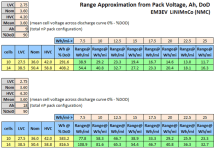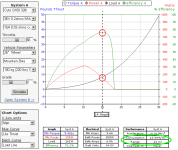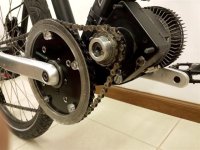lotrwiz said:
Wel I have a 36v 9ah Battery, I don;t suppose you could do the math on that for me, please? :/ I don't quite understand how you work it out.
dogman said:
The math will depend on lots of things hard to quantify, like how hard you pedal, that might be different for you. The numbers I spoke of were based on my riding, 10,000 miles worth of it.
But on a 40 mile ride, if you can't stop for a full recharge, you are about right on with your estimate of 20 miles of pedaling an extra heavy bike.
You really have to get more battery for those really long rides. If your buddies ride slow enough, and you are using a wattmeter to make sure you dont' start squandering your available battery, I see no reason why you could not learn to get 25 or even 30 miles out of what you have.
But I don't see 40 miles as doable, except under tailwind all the way conditions.
As dogman says - there are a lot attributes that are difficult to quantify, but for a simple estimate you can look at as a matter of the Wh capacity of your battery and your consumption in Wh/mi. This lumps all the attributes into a single magic 'consumption rate' - just trading a lot of little guesstimates for a single one

. You have a small motor and aren't speeding along so you should be able to keep in 15Wh/mi range. Here's some spreadsheet snippets that show 36v and 48v NMC cell batteries with 9Ah and 18Ah capacities. I'm just guessing on the chemistry of your battery and that it's a 10s configuration.
Your present battery is the top row - 36v nominal @ 9Ah. The columns represent different consumption rates. As you can see, dogman's estimate fo 20 miles looks about right at the 15Wh/mi rate. The columns will give you a feel for the ranges you can expect. On the flat and using very little power you can get 30 miles but a little headwind or incline and it's a no-go for sure.
The second table shows your kit after adding a second identical battery for a total of 18Ah, . This looks good for a certain 40 mile range. The other table rows are for '48v' batteries, just to give a notion of how that changes things.

Another way to go after an estimate is to use
Justin's simulator. The run below assumes a mountain bike with semi-upright posture, uses a small Q100 motor, a battery similar to yours, and a small 15A controller (just guessing there, but the run is at less than full throttle so the controller details aren't too important). The throttle was adjusted downward to get a no-pedal speed of 15mph. Here the red circles show the motor is running at about peak efficiency and the power needed to propel the bike (black line) will take about 158W of motor power or 200W of battery power (that efficiency thing...).
If you look at the green circle, you can see an estimate of about 14Wh/mi and a range of about 22 miles - this is pretty much as estimated above. This estimate is no-pedal and perhaps a little more optimistic, so you should be able to realize some additional distance from your personal pedaling contribution (lower Wh/mi). If you plug similar lower Wh/mi guesstimates from this run into the tables above, you will see the resulting ranges.

Anyhow - nothing too different from dogman's advice, but it may help give you confidence that his '10K mile seat of the pants' estimate is pretty much spot on (or at least agree with the estimates here that are wrapped in a little arithmetic...).






